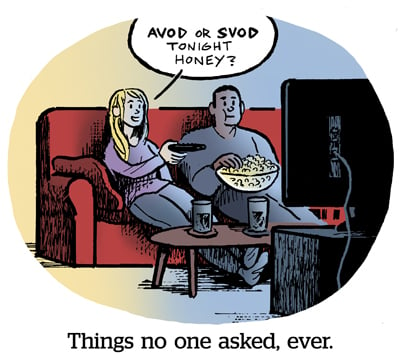
From traditional cable and subscription video-on-demand (SVOD) to free ad-supported streaming TV (FAST), viewers have more choices than ever before to construct their own unique content bundle. However, the personalization of television in the connected TV (CTV) era comes with search and discovery friction points for viewers. It also presents discoverability challenges for media networks.
In spite of internet-delivered TV transforming the consumer experience, TV’s advertising infrastructure and ad formats are slowly catching up to digital. Progress is being made to address discoverability and generally improve user experience across TV platforms.
Outstream ads, better instream ad targeting and more interactive user interfaces are just a few of the latest developments making it easier for viewers to discover new content and for advertisers to provide content recommendations.
Outstream ads emerge on TV
Outstream ads are featured outside of the programming feed, within the TV operating system’s navigation interface and homepage. Outstream display formats, from banner ads to video, present new inventory to attract viewers who have opted to pay for premium programming access without being interrupted by instream ads (e.g., standard pre- and mid-roll ads).
With outstream ads, media networks gain a way to showcase their content on different platforms where they’re facing discoverability challenges.
That being said, it’s a platform world, and brands and media networks are just living in it (for now). The platforms will ultimately own their outstream inventory. They’ll want to use these ads to their optimal monetization advantage, redirecting viewers to programming where the platform has a better revenue share, for example.
More agile, personalized media buys
In addition to outstream video ads emerging, instream video ad targeting is improving. Most TV platforms have convinced media networks to migrate SSAI (server-side ad insertion) activities to platforms’ native content delivery network (CDN) operating systems.
Simply put, this consolidates important back-end activities to ensure the efficient compiling and delivery of ad pods. It also creates a uniform base of analytics for advertisers to bid on specific spots in real time. In theory, this results in more opportunities for advertisers to execute agile media buys across the CTV ecosystem.
However, platforms need to play nice with viewer data. With advertisers making strides to improve creative versioning on CTV, media buyers should demand more information about user behavior patterns unique to each platform. The better the data exchange, the better the contextually relevant ad creative derivatives will be.
Ads encouraging voice-enabled navigation
As voice-enabled TV remote controlling proliferates, it’s likely media companies will deploy more TV ad creatives encouraging voice-enabled navigation to their programming.
Consider this: Programmers are some of the biggest TV ad spenders. One look at any top TV ad spender chart, and you’ll see media companies such as Paramount+ and Warner Bros. Entertainment consistently in the top 10. These same companies are also key players paying the pay-to-play app visibility game across OEMs and CTV platforms.
It would be wise for programmers to reimagine their creatives and demonstrate how viewers can use voice-enabled commands to flip the channel, save or record a program to watch later.
But this alone is not enough to resolve discoverability challenges.
Viewers want to choose their entertainment, but they also want options consistently displayed to them. Sure, features such as voice-enabled search will help to address matters, but the real issue is that disparate TV services lack a comprehensive menu of programming.
It’s not far-fetched to expect OEMs, streaming providers, and networks to collectively embrace more uniform TV UX enhancements and standards to improve the discoverability, personalization and fluidity of the CTV viewing experience.
Win the entry point, win TV attention
The environment in which someone is program surfing influences what content they watch, so the big TV attention battle lies with who can control the point of entry. Regardless of what TV brand I own, my preferred streaming TV experience – and that service’s programming offering – will be the first thing I tune in to on the big screen and where much of my subsequent content discovery happens.
Players who band together to develop new, engaging and consistent ways to display content, both programming and advertising, just might win the TV UX attention battle of tomorrow.
“On TV & Video” is a column exploring opportunities and challenges in advanced TV and video.
Follow Vevo and AdExchanger on LinkedIn.











